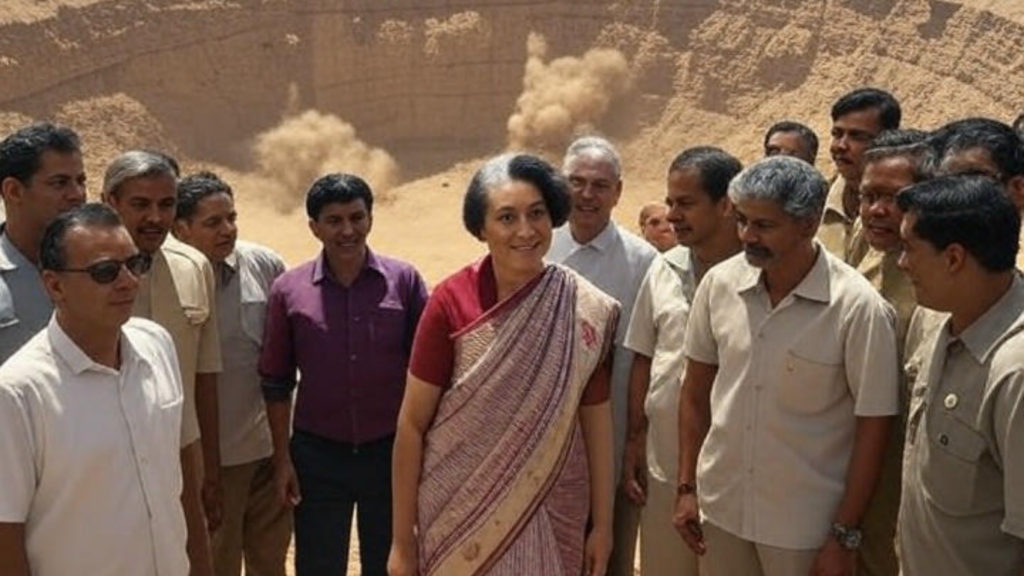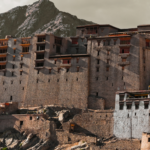On May 18, 1974, India made history with Operation Smiling Buddha, its first nuclear test in the deserts of Rajasthan. Hidden under the code name “Smiling Buddha,” this peaceful nuclear explosion at Pokhran showed the world that India could stand tall among global powers. The test wasn’t about war—it was about proving India’s scientific strength and protecting its future. Coming just three years after the 1971 war with Pakistan, it was a bold move that surprised nations like the U.S. and Canada. India became the sixth country to test a nuclear device, but the journey wasn’t easy. From secret planning to global backlash, this operation changed how the world saw India. Let’s break down what happened, why it mattered, and how it shaped India’s place on the global stage.
The Roots of Operation Smiling Buddha
India’s nuclear journey started long before 1974, driven by the dream of self-reliance. After independence in 1947, leaders like Jawaharlal Nehru saw science as a way to secure the nation. The 1962 war with China and Pakistan’s growing ties with the U.S. made India feel cornered. By 1964, China’s nuclear test pushed India to act. Scientists at the Bhabha Atomic Research Centre (BARC), led by Homi Bhabha and later Raja Ramanna, worked quietly to build a nuclear device. The government, under Prime Minister Indira Gandhi, gave the green light in 1972. They called it “Smiling Buddha” to signal peace, not war. The goal was to test a “peaceful nuclear explosive” for scientific progress, but it also sent a strong message to the world: India could defend itself.
India’s Nuclear Dreams
India’s nuclear program began in 1944 with Homi Bhabha’s vision of using atomic energy for growth. After China’s 1964 test, India felt the heat—its neighbors were getting stronger. Bhabha, before his death in 1966, pushed for a nuclear test. His successor, Raja Ramanna, took up the challenge at BARC. They wanted to show India could master this technology without foreign help. The 1971 war with Pakistan, which led to Bangladesh’s creation, added urgency. India needed to prove it wasn’t weak, even if the world wasn’t ready for it.
Why the Code Name “Smiling Buddha”?
The name “Smiling Buddha” wasn’t random. The test happened on Buddha Purnima, a day honoring peace and enlightenment. India chose this name to show the test wasn’t about weapons but about peaceful uses—like digging canals or mining. Indira Gandhi and her team wanted to avoid looking aggressive, especially after the 1971 war. But the name also had a hidden meaning: it was a cheeky nod to India’s quiet strength, smiling through challenges while proving its might to the world.
The Day of the Test: May 18, 1974
On May 18, 1974, at 8:05 AM, the Pokhran desert in Rajasthan shook with a massive underground explosion. The device, nicknamed “the Buddha,” was a 12-kiloton nuclear bomb, buried 100 meters deep. Scientists from BARC, along with the Indian Army, had prepared for months in secret. The test site, called Pokhran-I, was a remote spot chosen to avoid attention. When the bomb went off, it created a crater 150 meters wide and sent shockwaves across the globe. Raja Ramanna called Indira Gandhi with the code phrase, “The Buddha is smiling,” confirming success. India had done it—its first nuclear test was a triumph of science and grit, even if the world wasn’t happy about it.
Preparing in Secret
The test was a closely guarded secret. Only a handful of people, including Indira Gandhi and scientists like Ramanna and PK Iyengar, knew the full plan. They worked under the cover of the Defence Research and Development Organisation (DRDO). The device was built at BARC in Mumbai and moved to Pokhran in parts to avoid suspicion. The Army’s 61 Engineer Regiment dug the shaft at night, while scientists used fake names and disguises. Even the U.S., with its spy satellites, didn’t catch on until it was too late.
The Explosion and Its Impact
At 8:05 AM, the bomb exploded with a force equal to 12,000 tons of TNT. The ground shook, and a huge crater formed, with dust rising high into the sky. The blast was felt 50 kilometers away, but no radiation leaked, thanks to the deep shaft. Scientists cheered as years of hard work paid off. India’s leaders were thrilled—this wasn’t just a test; it was a symbol of India’s independence in science. But the world didn’t see it that way, and the fallout was just beginning.
The Science Behind the Test
The device for Operation Smiling Buddha was a big achievement for Indian scientists. It was a plutonium-based implosion bomb, similar to the one the U.S. used in 1945. India made the plutonium at its CIRUS reactor in Mumbai, using technology from Canada. The bomb weighed about 1,400 kilograms and was 1.5 meters wide. Scientists at BARC figured out how to trigger the explosion using a complex system of explosives and electronics—all built in India. They called it a “peaceful nuclear explosive” to study its uses for things like mining or creating reservoirs. But the technology was the same as a weapon, and that’s what worried other countries. India proved it could handle advanced science on its own, a huge step for a young nation.
Building the Device
The bomb was a plutonium implosion device, meaning it used explosives to squeeze the plutonium core until it exploded. India got the plutonium from the CIRUS reactor, which Canada had supplied in 1956 for peaceful use. BARC scientists, led by Ramanna and Iyengar, designed the bomb from scratch. They used a polonium-beryllium initiator to start the reaction, a tricky piece of tech they mastered without help. The device was bulky but effective, showing India’s ability to innovate under pressure.
A Peaceful Nuclear Explosive?
India insisted the test was for peaceful purposes, not war. They wanted to explore how nuclear blasts could help with big projects—like digging canals, moving earth for dams, or finding oil. The device was labeled a “peaceful nuclear explosive” (PNE), a concept popular in the 1960s. But the line between a PNE and a weapon was thin. The technology was the same, and other countries saw it as a step toward a bomb, even if India said it wasn’t planning to build one.
Global Reaction: From Shock to Sanctions
The world was stunned by India’s test. The U.S., Canada, and other nuclear powers didn’t see it coming. Within hours, news spread, and reactions poured in. The U.S. called it a “serious development,” worried about more countries going nuclear. Canada, which had helped India with the CIRUS reactor, felt betrayed and cut off nuclear cooperation. Japan and West Germany criticized India, while Pakistan vowed to speed up its own nuclear program. The test broke the global norm—no new country had tested a nuclear device since China in 1964. India faced sanctions, losing access to nuclear tech and materials. But some nations, like France, quietly supported India’s right to protect itself, showing the world was divided on how to handle this new nuclear player.
Anger from the West
The U.S. and Canada were the angriest. The U.S. feared India’s test would inspire others, like Pakistan, to build bombs, upsetting global balance. Canada stopped all nuclear aid, saying India misused the CIRUS reactor meant for peaceful use. The Nuclear Suppliers Group (NSG) was formed in 1975 to control nuclear exports, largely because of India’s test. Western media called India reckless, but Indian leaders stood firm, saying they had the right to defend their country in a tough neighborhood.
Pakistan’s Response
Pakistan was rattled. Just three years after losing the 1971 war, India’s test made them feel vulnerable. Prime Minister Zulfikar Ali Bhutto promised Pakistan would get its own bomb, “even if we have to eat grass.” Pakistan sped up its nuclear program, working with China to counter India. The test started a nuclear race in South Asia, raising fears of conflict. By 1998, Pakistan would test its own bomb, a direct result of the shock from Operation Smiling Buddha.
Why India Took the Risk
India knew the test would bring trouble, but the stakes were high. The 1962 loss to China and the 1971 war with Pakistan showed India needed a strong defense. Leaders like Indira Gandhi believed a nuclear test would make India safer, not by starting a war, but by showing strength. It was also about pride—India wanted to prove it didn’t need the West to succeed. The test came at a tough time, with India facing economic struggles and global pressure to sign the Non-Proliferation Treaty (NPT). But India refused, calling the NPT unfair since it let big powers keep their bombs while stopping others. The test was a gamble, but it made India a serious player on the world stage.
A Message of Strength
The test was India’s way of saying, “We can stand up for ourselves.” After China’s 1964 test and Pakistan’s alliances with the U.S., India felt surrounded. The 1971 war, while a win, showed how quickly tensions could flare. A nuclear test gave India a shield—enemies would think twice before attacking. It also boosted national pride. For a country often seen as poor and struggling, Operation Smiling Buddha proved India could achieve big things, even against the odds.
Rejecting Global Pressure
The world wanted India to sign the NPT, a 1968 treaty to stop the spread of nuclear weapons. But India said no—the treaty let the U.S., USSR, and others keep their bombs while banning new countries from joining the club. India called it unfair and stood its ground. The test was a bold rejection of that pressure, showing India would chart its own path, even if it meant facing sanctions and criticism.
The Legacy of Operation Smiling Buddha
Operation Smiling Buddha changed India forever. It made India the sixth nuclear power, after the U.S., USSR, UK, France, and China. The test led to tighter global rules, like the NSG, but it also forced the world to take India seriously. At home, it inspired a generation of scientists and boosted confidence in India’s tech capabilities. However, it also started a nuclear race with Pakistan, raising tensions in South Asia. India didn’t test again until 1998, but the 1974 test laid the groundwork for its nuclear program. Today, India’s nuclear strength is a key part of its defense, all thanks to that historic day in Pokhran—a day that showed the world what India could do.
Shaping India’s Nuclear Future
The 1974 test was just the beginning. India kept developing its nuclear tech, despite sanctions. By 1998, under Operation Shakti, India tested five more devices, officially becoming a nuclear weapons state. The success of Smiling Buddha gave India the confidence to build a strong deterrent, with missiles like Agni and Prithvi. Today, India has about 170 nuclear warheads, a direct legacy of that first test. It also pushed India to focus on self-reliance, building its own reactors and tech.
A New Era in South Asia
The test reshaped South Asia. Pakistan’s nuclear program sped up, leading to its 1998 test. The region became a nuclear flashpoint, with India and Pakistan often on edge. But the test also made India a regional power, balancing China’s influence. Globally, it forced a rethink of nuclear rules, though India still doesn’t sign the NPT. Operation Smiling Buddha wasn’t just a scientific win—it changed the power dynamics of the region for decades.



